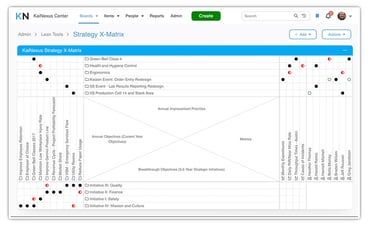/Boards/Board%20Designs/Kanban%20Board/Kanban%20Board%20One%20Card.png?width=500&name=Kanban%20Board%20One%20Card.png) In the post-WW II era, Toyota realized that they could improve profitability and product quality by matching parts inventory with real-time demand to create a “just-in-time” production and provisioning process. To achieve this, they implemented a visual system to track the movement of parts from the supplier to storage locations and finally to the assembly line. This approach lowered costs, improved quality, and accelerated the rate of production.
In the post-WW II era, Toyota realized that they could improve profitability and product quality by matching parts inventory with real-time demand to create a “just-in-time” production and provisioning process. To achieve this, they implemented a visual system to track the movement of parts from the supplier to storage locations and finally to the assembly line. This approach lowered costs, improved quality, and accelerated the rate of production.
They named the process “Kanban,” a Japanese word that translates to “signboard” or “visual signal” in English. The method was so effective that Kanban Cards were adopted by manufacturing companies worldwide to help structure and control the production and procurement of parts. Today, the principles of Kanban and Kanban boards are effectively used by organizations in many industries beyond just manufacturing.
The Principles of Kanban
Before we get into what a Kanban board looks like and how it is used, it is helpful to understand the guiding principles of the approach. There are four fundamental ideas:
1: Visualize the workflow
The purpose of Kanban is to make apparent where each element of work-in-progress stands, whether it is waiting to be started, actively being worked, or complete. Anything that stalls progress, including blockers, bottlenecks, and queues, becomes apparent by visualizing the workflow. The task of visualizing WIP is ongoing.
2: Limit work in progress
Kanban’s ultimate goal is an uninterrupted flow of value to the customer. Work only moves from one stage to the next when there is demand either by a customer or the next stage of the process. This means that the pipeline of work-in-progress must be limited to what can be reasonably managed at any point in time. Work is never forced through the stages unless there is a pull of demand. This ensures that work does not pile up for any one person or team, which is an essential element of quality management.
3: Focus on flow
With the first two principles in place, work will flow freely through the process. That means that any interruption in flow requires attention and represents an opportunity for additional visualization and improvement.
4: Continually improve
Visualized workflows are easier to improve because deficiencies are laid bare. Organizations with a culture of continuous improvement use Kanban to perfect processes, never to blame people.
In addition to these core principles, the practice of Kanban requires consistent communication and feedback. Teams are most successful when there are explicit policies for managing work-in-progress and when those policies are clearly communicated. Kanban should be considered a collaborative effort in which respect for people is always practiced.
How are Kanban Boards Structured?
The structure of a Kanban board depends on the process being visualized and the nature of the work. However, the most common design includes the following elements:
Kanban Cards: Each Kanban card is the visual representation of a task. The card contains information about the task, including its current status, deadline, owner, and description.
Kanban Columns: The Kanban board columns represent the various stages of the process workflow. Cards move through the flow until they are complete. The simplest column structure is “To Do, Doing, Done.”
Work-in-Progress (WIP) Limits: WIP limits represent the maximum number of tasks allowed in the different stages of the workflow. Enforcing WIP limits helps the team complete the flow faster by focusing only on a reasonable number of current tasks.
Kanban Swimlanes: Swimlanes are horizontal divisions that can be used to separate different categories of tasks, teams, projects, or classes of activity.
/Boards/Board%20Designs/Kanban%20Board/Kanban%20Board%20Cards.png?width=750&name=Kanban%20Board%20Cards.png)
What are the Advantages of Digital Kanban Software?
While Toyota’s initial approach to Kanban used physical cards and paper Kanban boards are pretty common, modern organizations are opting for software that supports making Kanban boards digital. There are multiple benefits to this method.
Digital Kanban Creates a Historical Record
A physical Kanban board can only contain so much information, and by its nature, it changes frequently. Because of this, it is more like a snapshot than a complete record of the flow of work. Digital boards, on the other hand, have no limit to the type and amount of information that can be added. Additionally, they give you the details of every time a card is moved from one column to another so you can recreate the workflow and look for opportunities for improvement.
Workers Can Engage from Anywhere
Physical Kanban boards work well for organizations where everyone does the work at the same place and at the same time. Still, many workers, especially information workers, these days spend some or all of their time working remotely. Digital Kanban tools improve teamwork by allowing them to visualize work from wherever they happen to be.
Alerts and Notifications are Enabled
When a deadline that is written on a piece of paper comes and goes, not much happens. With digital Kanban, on the other hand, team members can configure the system to send alerts and notifications to the right individuals. This ensures that forward momentum is maintained.
Leaders Can Engage with Multiple Boards
Ideally, the organization will broadly use the Kanban approach to workflow management. Kanban software is ideal for making it easy for leaders to get insight into what is happening with each team, department, or location. 
Kanban is Managed Alongside Other Improvement Tools
For most organizations, Kanban is one of many ways to support structured improvement. With a robust improvement technology platform, organizations can manage Kanban seamlessly along with other techniques, such as the X-matrics, A3 reporting, impact analytics, engagement reporting, and more.
Kanban Boards in Software Development
We mentioned that Kanban is used by industries ranging from healthcare to construction, but they are prevalent in the software development sector.
In 2010, David J. Anderson released ‘Kanban: Successful Evolutionary Change for Your Technology Business.‘ It is now one of the most all-time successful books dedicated to the Agile approach to software development.
For Agile teams, Kanban boards, also called scrum boards, help manage changing customer requirements and strategic priorities. With Kanban, changing requirements can be accommodated even late in the development cycle. In addition, it improves scope control because it limits work in progress and visualizes potential blockages. Kanban also helps make delivery more predictable and helps everyone understand WIP lead time.
A software development Kanban board flow often includes a user story, product requirements, solution design, development, quality assurance, go-to-market activities, documentation, and delivery.
Kanban in Lean Manufacturing
A Kanban system can support the entire value chain of any Lean manufacturing process. It can visualize work in progress from the materials supplier to the final customer and every step in between. This helps project managers control inventory and manage tasks throughout the production cycle from procurement to delivery.
To be most effective in manufacturing, Kanban should be used throughout the entire value chain. This ensures continuous improvement and waste reduction are supported while still balancing the resources with production needs. For example, bottlenecks slow production because there is too little or too much supply of materials or work-in-progress for process operators. With Kanban’s pull system, operators control the workflow. Over time, Kanban achieves the goal of increasing production quality and efficiency.
Whatever your industry, Kanban boards are a helpful way to accelerate processes, identify blockers that require attention, engage employees in improvement, and ultimately deliver quality products to your customers.




Add a Comment